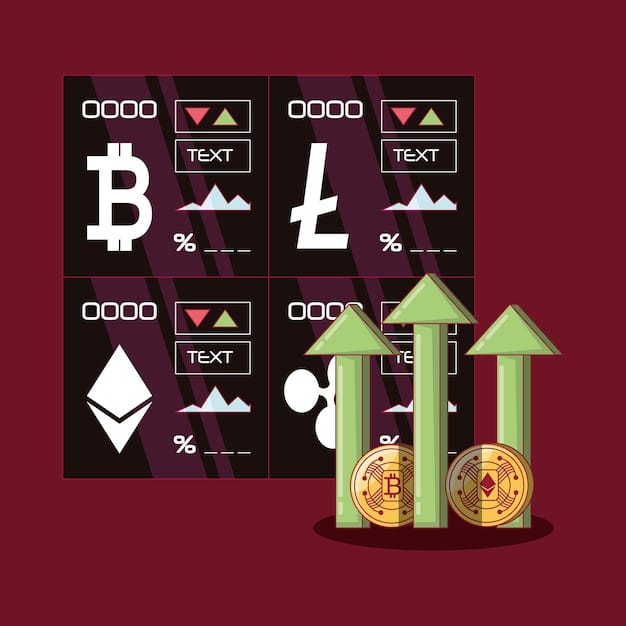Yield Farming on Solana: Maximize Returns with Altcoin Pools (US 2025)

Yield farming on Solana, particularly with altcoin pools in the US, presents an opportunity for investors to maximize returns through providing liquidity to decentralized exchanges and earning rewards, while navigating risks and regulatory landscapes in 2025.
Yield Farming on Solana: Maximizing Returns with Altcoin Pools in the US (Updated January 2025) offers lucrative opportunities for crypto investors, especially those looking to diversify beyond mainstream assets and tap into the high-speed, low-cost environment of the Solana blockchain; but how can you navigate this complex landscape to maximize your returns and minimize risks? Let’s dive in and explore strategies for successful yield farming in the US.
Understanding Yield Farming on Solana
Yield farming on Solana involves providing liquidity to decentralized exchanges (DEXs) and other DeFi platforms in exchange for rewards. This process allows users to earn passive income by staking their cryptocurrency holdings, contributing to the functionality and liquidity of the network. The Solana blockchain offers unique advantages, such as faster transaction speeds and lower fees compared to other blockchains, making it an attractive option for yield farmers.
The basic principle behind yield farming is to deposit cryptocurrency tokens into liquidity pools, which are essentially smart contracts that facilitate trading on DEXs. In return for providing liquidity, users receive rewards in the form of transaction fees and newly minted tokens, which can then be reinvested to further compound their earnings. Understanding the mechanics of liquidity pools, impermanent loss, and the various DeFi protocols available on Solana is crucial for successful yield farming.
Key Components of Solana Yield Farming
Several key components are essential for understanding and participating in yield farming on Solana. These components include liquidity providers, liquidity pools, automated market makers (AMMs), and yield aggregators.
- Liquidity Providers: These are the users who deposit their tokens into liquidity pools, providing the necessary liquidity for traders to execute transactions.
- Liquidity Pools: Smart contracts that hold the deposited tokens and facilitate trading on DEXs. These pools often consist of token pairs, allowing users to trade one token for another.
- Automated Market Makers (AMMs): DEXs that use algorithms to determine the price of assets based on the supply and demand within the liquidity pools. AMMs eliminate the need for traditional order books, making trading more efficient.
- Yield Aggregators: Platforms that automatically move funds between different yield farming opportunities to maximize returns. These aggregators help users optimize their yield farming strategies by identifying and capitalizing on the most profitable pools.
Understanding these components is essential for anyone looking to delve into yield farming on Solana. Knowing how each element works and interacts with the others can help you make more informed decisions and increase your chances of success.
In summary, Solana offers a promising landscape for yield farming, leveraging its technological advantages for higher efficiency and lower costs. By understanding the basics and key components, investors can strategically participate in DeFi to maximize their earnings.
Benefits of Solana for Yield Farming in the US
Solana offers various benefits for yield farming, especially for users in the United States. Its unique architecture and consensus mechanism provide significant advantages over other blockchain networks, making it an attractive platform for DeFi activities. These benefits include high transaction speeds, low transaction fees, and a growing ecosystem of DeFi projects.
The Solana blockchain is capable of processing thousands of transactions per second (TPS), significantly faster than many other blockchains. This speed is crucial for yield farming, where transactions need to be executed quickly and efficiently. Additionally, Solana’s transaction fees are significantly lower than those on networks like Ethereum, making it more cost-effective for users to participate in yield farming activities.
Speed and Cost Efficiency
One of the most significant advantages of Solana is its speed and cost efficiency. The network’s architecture allows for near-instant transaction confirmations at a fraction of the cost compared to other blockchains. This is particularly beneficial for yield farmers who may need to frequently move funds between different pools or execute complex strategies.
The high throughput of the Solana network minimizes congestion, ensuring that transactions are processed quickly, even during periods of high demand. This speed is crucial for capturing time-sensitive opportunities in the DeFi market and optimizing yields. The low transaction fees also make it more economically viable for users to participate in smaller yield farming opportunities.
Growing DeFi Ecosystem
Solana’s DeFi ecosystem has been rapidly expanding, with new projects and protocols launching regularly. This growth provides yield farmers with a diverse range of opportunities to earn rewards on their cryptocurrency holdings. The ecosystem includes DEXs, lending platforms, and other DeFi applications, each offering unique yield farming strategies.
Platforms like Raydium, Orca, and Saber have become popular hubs for yield farming on Solana, offering a variety of liquidity pools and farming incentives. These platforms provide users with the tools and resources they need to participate in yield farming and earn passive income. The growing ecosystem also fosters innovation, with new DeFi protocols and yield farming strategies constantly emerging.

In conclusion, Solana’s high transaction speeds, low fees, and growing DeFi ecosystem make it an ideal platform for yield farming in the US. These advantages provide users with the tools and resources they need to maximize their returns and navigate the DeFi landscape effectively.
Navigating Altcoin Pools on Solana
Altcoin pools on Solana offer unique opportunities for yield farming, allowing users to diversify their holdings and potentially earn higher returns compared to traditional cryptocurrency pools. However, navigating these pools requires careful consideration and understanding of the associated risks. Altcoins are generally more volatile than mainstream cryptocurrencies, which can impact the stability and profitability of yield farming investments.
When engaging with altcoin pools, it’s essential to conduct thorough research and due diligence on the specific tokens involved. Understanding the project’s fundamentals, tokenomics, and market capitalization can help investors assess the potential risks and rewards. Additionally, monitoring the pool’s trading volume and liquidity is crucial for ensuring smooth and efficient transactions.
Risks and Mitigation Strategies
Investing in altcoin pools comes with certain risks, including impermanent loss, rug pulls, and smart contract vulnerabilities. Impermanent loss occurs when the price of the tokens in the pool diverges significantly, resulting in a decrease in the value of the liquidity provided. Rug pulls are scams where the developers of a project abandon it, taking the invested funds with them. Smart contract vulnerabilities can be exploited by hackers, leading to the loss of funds.
- Diversification: Spreading investments across multiple altcoin pools can help mitigate the impact of any single pool performing poorly.
- Due Diligence: Conduct thorough research on the tokens and projects involved, assessing their legitimacy and long-term potential.
- Smart Contract Audits: Look for pools that have undergone audits by reputable security firms to ensure the smart contracts are secure.
- Monitoring: Regularly monitor the performance of the pools and the prices of the tokens involved, making adjustments as needed.
By understanding and addressing these risks, investors can enhance their chances of success when yield farming with altcoin pools on Solana. Careful planning and ongoing monitoring are essential components of a sound yield farming strategy.
In summary, navigating altcoin pools on Solana requires a strategic approach, careful risk management, and continuous monitoring. By understanding the potential pitfalls and implementing mitigation strategies, investors can enhance their chances of maximizing returns while minimizing risks.
Popular Solana DeFi Platforms for Yield Farming
Several DeFi platforms on Solana have gained popularity for their yield farming opportunities. These platforms offer a variety of liquidity pools, farming incentives, and innovative features that attract yield farmers. Some of the most prominent platforms include Raydium, Orca, and Saber.
Each platform has its unique characteristics and offerings, catering to different types of yield farmers. Raydium, for example, is known for its integration with Serum, a decentralized order book exchange, providing users with access to a wide range of liquidity pools and trading opportunities. Orca, on the other hand, focuses on providing a user-friendly and intuitive trading experience, making it easier for newcomers to participate in DeFi.
Raydium
Raydium is an automated market maker (AMM) and liquidity provider built on the Solana blockchain. It provides users with access to a wide range of liquidity pools and trading opportunities, leveraging the speed and efficiency of the Solana network. Raydium’s integration with Serum allows users to access a decentralized order book exchange, enabling them to trade tokens with greater liquidity and precision.
The platform offers various yield farming incentives, rewarding users who deposit their tokens into liquidity pools with RAY tokens, Raydium’s native token. These rewards can then be reinvested to further compound earnings. Raydium’s user interface is relatively straightforward, making it accessible to both novice and experienced yield farmers.
Orca
Orca is another popular AMM on Solana, known for its user-friendly interface and simplified trading experience. Orca aims to make DeFi more accessible to a wider audience by providing a seamless and intuitive platform for trading and yield farming. The platform offers a variety of liquidity pools, focusing on popular token pairs and stablecoin pairs.
Orca’s native token, ORCA, is used to incentivize users to provide liquidity to the platform. Users who deposit their tokens into Orca’s liquidity pools receive ORCA tokens as rewards, which can then be staked or reinvested to further boost their earnings. Orca’s focus on simplicity and user experience has made it a favorite among newcomers to DeFi.

In summary, platforms like Raydium and Orca are prominent in the Solana DeFi space, offering unique features and opportunities for yield farming. Whether you’re looking for advanced trading options or a user-friendly experience, Solana’s DeFi landscape has something for everyone.
Regulatory Considerations for US Yield Farmers
Regulatory considerations are crucial for US yield farmers participating in the Solana ecosystem. The legal and tax implications of yield farming can be complex and vary depending on the jurisdiction. It’s essential for US residents to understand and comply with the relevant regulations to avoid potential legal and financial issues.
The IRS (Internal Revenue Service) has not yet provided specific guidance on the tax treatment of yield farming activities. However, existing tax laws and regulations can be applied to the income and gains generated from yield farming. Generally, income earned from providing liquidity and receiving rewards is taxable as ordinary income.
Tax Implications
Understanding the tax implications of yield farming is critical for US residents. The IRS considers cryptocurrency to be property, and any gains or losses from trading or investing in cryptocurrency are subject to capital gains taxes. Similarly, the rewards earned from providing liquidity in yield farming pools are considered taxable income.
- Ordinary Income: Rewards earned from providing liquidity are typically taxed as ordinary income. The fair market value of the tokens received as rewards should be reported as income in the year they are received.
- Capital Gains: When selling or trading tokens earned through yield farming, any gains or losses are subject to capital gains taxes. The holding period determines whether the gains are taxed as short-term or long-term capital gains.
- Record Keeping: Maintaining accurate records of all yield farming transactions is essential for tax reporting purposes. This includes tracking the dates of transactions, the amounts involved, and the fair market value of the tokens at the time they were received.
It is advisable to consult with a tax professional who is knowledgeable about cryptocurrency taxation to ensure compliance with all applicable tax laws and regulations. Professional guidance can help yield farmers navigate the complex tax landscape and minimize their tax liabilities.
In summary, US yield farmers must be aware of the regulatory considerations and tax implications associated with their activities. Compliance with tax laws and regulations is essential for avoiding potential legal and financial issues. Consulting with a tax professional is highly recommended to ensure accurate and compliant tax reporting.
Future Trends in Solana Yield Farming (2025)
Looking ahead to 2025, several future trends are expected to shape the landscape of yield farming on Solana. These trends include the emergence of new DeFi protocols, the integration of cross-chain solutions, and the evolution of yield optimization strategies. As the Solana ecosystem continues to mature, yield farmers can anticipate more sophisticated and efficient ways to earn rewards on their cryptocurrency holdings.
One of the key trends is the development of new DeFi protocols that offer novel yield farming opportunities. These protocols may focus on specific niches, such as decentralized lending, insurance, or derivatives trading. The integration of cross-chain solutions will also play a significant role, allowing users to seamlessly move assets between different blockchain networks and access a wider range of yield farming opportunities.
Emerging DeFi Protocols
The Solana ecosystem is expected to see the emergence of new DeFi protocols that offer innovative yield farming opportunities. These protocols may focus on specific niches, such as decentralized lending, insurance, or derivatives trading. By participating in these emerging protocols, yield farmers can gain exposure to new assets and potentially earn higher returns.
For example, protocols that offer undercollateralized lending or decentralized options trading could provide unique yield farming incentives. By providing liquidity to these protocols, users can earn rewards in the form of transaction fees and newly minted tokens. However, it’s essential to conduct thorough research and due diligence on these emerging protocols to assess their legitimacy and long-term potential.
Cross-Chain Solutions
The integration of cross-chain solutions will enable users to seamlessly move assets between different blockchain networks and access a wider range of yield farming opportunities. This will allow yield farmers to diversify their holdings and take advantage of the most profitable pools across different blockchains.
Protocols like Wormhole and Allbridge are already facilitating cross-chain asset transfers on Solana. As these solutions become more mature and widely adopted, yield farmers will have greater flexibility and efficiency in managing their assets and maximizing their returns. The integration of cross-chain solutions will also foster greater interoperability within the DeFi space, making it easier for users to access and utilize different DeFi protocols.
In summary, the future of yield farming on Solana in 2025 looks promising, with the emergence of new DeFi protocols and the integration of cross-chain solutions. Yield farmers can expect more sophisticated and efficient ways to earn rewards on their cryptocurrency holdings, but it’s crucial to stay informed and adapt to the evolving landscape to maximize their success.
| Key Point | Brief Description |
|---|---|
| 🚀 Solana Benefits | High speed, low fees make Solana ideal for yield farming. |
| ⚠️ Altcoin Risks | Volatility and scams require careful navigation. |
| 🚜 DeFi Platforms | Raydium and Orca offer diverse farming opportunities. |
| ⚖️ US Regulations | Tax implications and compliance are crucial for US farmers. |
FAQ: Yield Farming on Solana
Yield farming on Solana involves providing liquidity to decentralized exchanges and earning rewards, taking advantage of Solana’s high speed and low transaction costs to maximize returns.
Solana’s blockchain boasts high transaction speeds and low fees, making it an efficient and cost-effective platform for participating in yield farming activities, especially beneficial for frequent transactions.
Altcoin pools can come with risks like impermanent loss, rug pulls, and smart contract vulnerabilities, necessitating thorough research and diversification to mitigate potential losses.
In the US, yield farming rewards are typically taxed as ordinary income, and any gains from selling or trading those tokens are subject to capital gains taxes, requiring accurate record-keeping.
Platforms like Raydium and Orca are commonly used for yield farming on Solana, offering various liquidity pools and farming incentives to attract both new and experienced DeFi users.
Conclusion
Yield farming on Solana, especially with altcoin pools, can be a rewarding endeavor for US investors in 2025, offering opportunities to maximize returns within the fast and low-cost Solana ecosystem. However, it requires a strategic approach, careful risk management, and regulatory awareness to navigate the complexities and potential pitfalls of DeFi.





